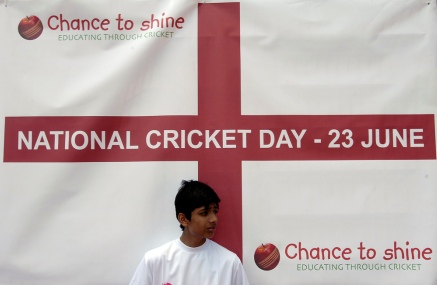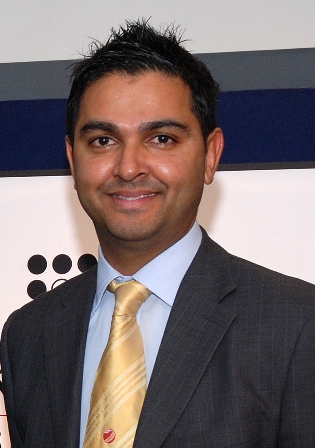
Waiting for the call: National Cricket Day in Hackney, East London
Wasim Khan: going in to bat for cricket
Having established his credentials in first-class cricket, Wasim Khan created the Chance to Shine programme to bring cricket into schools and make sure that youngsters’ progress within the game is not as reliant on luck as his had been. Mick Owen went to Birmingham to find out more about the development programme that has gained an international reputation and ask if Wasim’s mum is still angry about having her best kitchen knife used to carve a bat.

Waiting for the call: National Cricket Day in Hackney, East London
As the country is currently being run by a man whose only job other than ‘politician’ was in public relations, the average Briton would do well to learn the difference between spin and substance. No part of the public realm is immune to the work of the PR person and all too often this leads to disappointment when the reality behind the image becomes apparent. With Wasim Khan there is no disappointment. The stories about his upbringing and development as a first-class cricketer may have the slight variation that oft-recounted tales develop but behind the public face is a modest yet passionate, consummate professional who is building a facet of the cricket development system, leading the line for British Muslims in sport and acting as a role model for managers in sports development and beyond.
The Leisure Review met Khan, the chief executive of Chance to Shine – cricket’s way of developing cricket in state schools and of forging school to club links – in a well appointed office block by the canal in central Birmingham. The surroundings spoke of efficiency, purpose and achievement and the 39-year-old is clearly at ease, both in that space and in his own skin. Khan was “the first British-born Muslim to play county cricket”. He is careful about the definition but quite happy to discuss its repercussions. “A lot of people have said to me – players who came through after me – that they had gained a lot of inspiration from the fact that I had done it. Especially as at that time there was a perception that people of an ethnic minority background didn’t really get an opportunity in that environment.” His breakthrough was to play for Warwickshire the highest echelon of the game below Test cricket and this “gave hope” to others. Reflecting on the use of the word ‘pioneer’, Khan is happier to say, “By opening up the doors I said to other people, ‘Actually you can do this as well.’” This itself could be a mantra for the Chance to Shine programme.
Khan is keen to discuss the programme, his five-year-old baby, but his powerful back story warrants investigation. Did he really whittle a cricket bat from a piece of fencing? “We just didn’t have a bat because we couldn’t afford one but the fence at the bottom of the garden had a lump of wood hanging off it. It was curved at the bottom like a cricket bat so we took it off and carved out a handle using my mother’s biggest, sharpest kitchen knife.” Using this “quite cool” piece of equipment, Khan played street cricket using televised matches as a guide. How he came to see Wasim Khan’s Pakistan play in the flesh at Edgbaston is another story, which involves a fence rather than a gate, and by the time he was a pupil at Oldknow School the future opening batsman had begun to develop. It is part of Khan’s mission to ensure that no future cricketer, of whatever quality, has to risk their mother’s ire or that of the stewards at their nearest county ground, to get his or her hands on a cricket bat or access to role models and expertise.
The next stage in Khan’s development also helps explains some of his passion for ensuring sustainable cricket development in as many of the nation’s schools as he can reach. As a pupil at the same school that gave the world Dennis Amiss, a man who opened the batting for Warwickshire and England and took a double hundred off the West Indies attack in their pomp, Khan played cricket in the playground, where he was spotted by a teacher, Peter Bolland. “He would stand at the window at break time and watch us play. He saw me play an ‘immaculate forward defensive’ and called me over when the bell went. I thought I was in trouble but instead he asked where I had learned my cricket and said, ‘I want to send you for trials with Warwickshire.’” Bolland took the youngster for trials and the county offered to “work with you during the winter”. Khan joined the county under-13 squad, which he captained, and moved through to the first eleven where, by 1995, in the words of his biography, Brimful of Passion, “the left-handed opener was scoring runs for fun for the all-conquering and history-making Warwickshire team that took the county scene by storm”. For the record, Khan’s career batting average is over 30 and with a highest score of 181 he could reasonably be regarded as “a decent bat”.
Khan’s playing career never fulfilled its early promise and at the age of 31 he cut it short and started a new chapter with coaching and development as its title. After a spell managing his own coaching company, Khan was recruited by the Cricket Foundation and in 2005 established the Chance to Shine programme with the brief to develop cricket in state schools and to “take away the element of chance” in the way young people come to cricket. Had Peter Bolland been looking the other way, Wasim Khan may never have played first-class cricket and the beneficiary of Bolland’s commitment, love of cricket and contacts within the county set-up wants to ensure that, in future, luck is not part of cricket’s development strategy.
Chance to Shine is not about finding the next Khan, Pietersen or Flintoff; it is about giving as many young people as possible the opportunity to experience and enjoy cricket in as sustainable a manner as possible. “A big part of our sustainability strategy is developing the capacity of teachers, getting them qualified as coaches,” explains Khan, “Not just one but at least two and three in every school. It’s not about making them county coaches. It’s about helping them see that, in terms of striking or fielding, it’s not complicated, it’s not difficult. We are countering the perception, which we find in 90% of the schools when we first approach them, that cricket is complicated, that it needs lots of kit and takes a long time.” As Khan outlines the way Chance to Shine works, his enthusiasm is evident. The programme was built by him and it reflects his philosophy. “Every school that we go into [our commitment] is for five years. If a club wants to be involved in Chance to Shine we link them to six schools and work with them all for five years.” With the average sports development intervention being about three years at best, this is a real departure. “We work with schools throughout the programme so that by the end of Year 5 cricket in that school is sustainable and key to that is getting the teachers qualified to UKCC Level 1 and letting them to co-deliver with the coaches before they take on the delivery with the coach stepping back.” It seems a very structured approach, very much a programme to be followed. “It is very structured and it links in to the club structure. We feel the local club has to be involved to provide an exit route.”
The issue of school-to-club links is a perennial problem for all mainline sports. Despite the Youth Sports Trust having entered its second strategy cycle aimed solely at this vital link, Khan cites a national average, saying, “If between 3% and 4% of kids migrate from school to clubs in sports development that’s a good figure.” This and the issue of retention, which he links to providing opportunities for competition, are key areas. “I guess what we are going to be measured on is, if we go back to a school in five years time will they still be playing? And that is very dependent on the teachers and the head teacher. It’s a bit like sponsorship. If the boss of a major sponsor moves on the sport gets a little nervous waiting to see the attitude of the replacement.” All the evidence points to Khan’s end-of-first-term report being positive. There has been drop-off and, with the review of the first five year cycle imminent, Khan does not pretend that the programme has been 100% successful. Having said that, other sports are asking him how he has done what he has done, as are cricket governing bodies from around the world.
Sport’s major sponsor in the UK is the government and, given the circles Khan moves in, does he have a view on the incoming team at the Department for Culture, Media and Sport? “Funnily enough, when Hugh Robertson was shadow minister for sport he was a huge fan of Chance to Shine,” Khan says. Which would probably put him in a sizeable majority. Most who see the part-government funded, part-privately funded, part-charitably funded programme hoping to disburse £50 million pounds to help schools, clubs and children get the most from their cricket as a pretty good model and being held up as a model is something Wasim Khan is quite comfortable with, whether its for young Asian cricketers or the sports development profession here and abroad.
The Leisure Review, June 2010
© Copyright of all material on this site is retained by The Leisure Review or the individual contributors where stated. Contact The Leisure Review for details.
Download a pdf version of this article for printing

Chance to Shine ambassador Caroline Atkins whips up enthusiasm

Wasim Khan: now offering chances at the crease